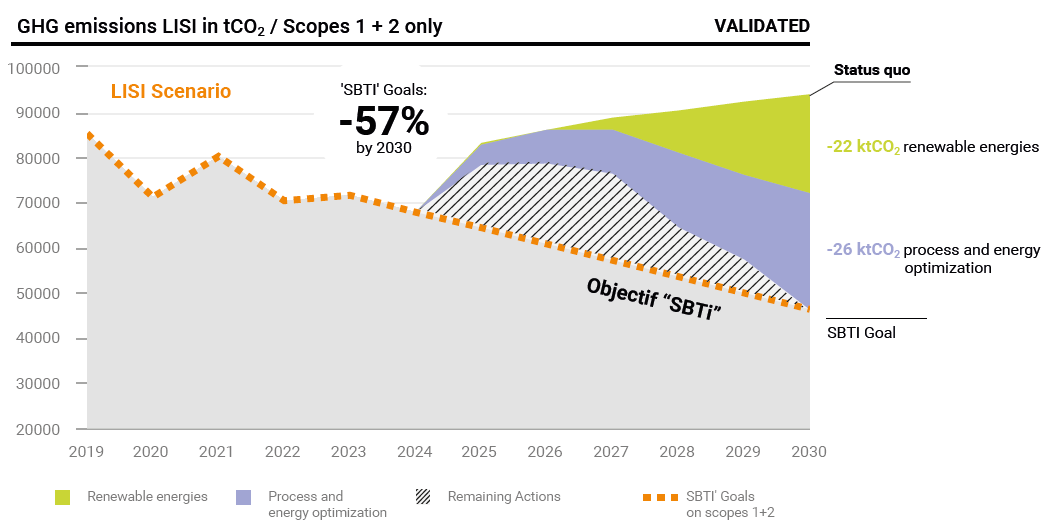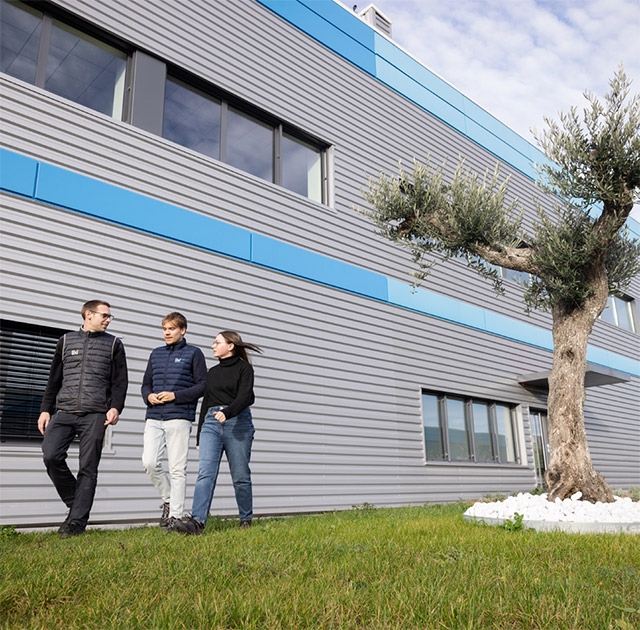Strategy
Planet


In 2024, LISI defined its climate strategy through rigorous scenario modeling, setting a goal that is both ambitious and realistic. The trajectory for reducing greenhouse gas emissions by 2030 is underway. Projects for self-production of renewable energy and continuous optimization of industrial processes have been expanded. Efforts to reduce water consumption have also intensified.
# Challenges & Objectives |
2023 | 2024 |
|---|---|---|
AXIS 3 : PROTECT OUR ENVIRONMENT |
-37% vs 2019 |
-36% vs 2019 |
AXIS 3 : PROTECT OUR ENVIRONMENT |
0.4 % | 0.7 % |
AXIS 3 : PROTECT OUR ENVIRONMENT |
1.7 % | 1.8 % |
AXIS 4 : WORK WITH OUR TERRITORIES |
100 %** | 65 % |
* SDG: Sustainable development goals / GRI : Global Reporting Initiative.
** 100% of sites in water stress zones defined an action plan in 2023, and 65% implemented their action plan in 2024.
Carbon Trajectory
A balanced vision
for 2030
In 2024, LISI redefined its 2030-2040 carbon trajectory through a strategic analysis of three impact scenarios (low, medium, high). The Board of Directors approved a balanced and ambitious roadmap, which is now fully operational. This rigorous approach enabled the precise quantification of the necessary investments in Opex(1) and Capex(2) to implement the 52 strategic action families identified across the Group. “This modeling marks a decisive turning point: our environmental ambitions are now transformed into precise, measurable, and actionable objectives,”, emphasized Yannick Danillon, CSR Manager, LISI.
A more accurate carbon footprint
This approach has transformed our carbon management, now providing a highly precise mapping of the Group’s emissions. Our measurement system accurately captures real CO2-equivalent flows, both in consumption and production. This strategic visibility fully encompasses Scope 1 — direct GHG emissions generated by the company — Scope 2 — indirect emissions from the production processes of goods (such as energy) — and a significant portion of Scope 3 (purchases of goods, services, etc.). For the particularly complex Scope 3, our teams have developed a robust methodology that accounts for the geographic and industrial specifics of our supplier ecosystem.
(1) Opex: operating expenses for the day-to-day operation of the company.
(2) Capex: expenses committed for long-term investments.

SBTI Methodology
To ensure the robustness of its calculations, the Group has chosen to adopt the methodology of the Science Best Target Initiative (SBTI). This initiative, which aims to support companies in their efforts to reduce greenhouse gas emissions, provides a benchmark aligned with the goal of limiting global warming to 1.5°C, as established by COP27.
# 2030 Goal: Reduce GHG emissions by 57% for Scopes 1 and 2 only, in line with SBTi standards

Water Consumption
Anticipating challenges and
securing our operations
In 2024, the LISI Group undertook an in-depth analysis of water usage, identifying sites located in areas of water stress and those with annual water consumption exceeding 10,000 m3. This forward-looking study, projected through 2050, served as a powerful mobilization tool for site directors to address water resilience challenges.
In response to critical zones, the Group immediately implemented a three-pronged action plan: structural reduction of water consumption, maximization of alternative resources (such as rainwater harvesting and closed-loop systems), and operational self-sufficiency. By the end of 2024, 65% of our sites in sensitive areas had robust action plans in place, with some capable of temporarily halting natural water withdrawals during critical periods to ensure continuity of operations.


 Reduce greenhouse gas emissions:
Reduce greenhouse gas emissions: % of water stress area sites with an action plan
% of water stress area sites with an action plan